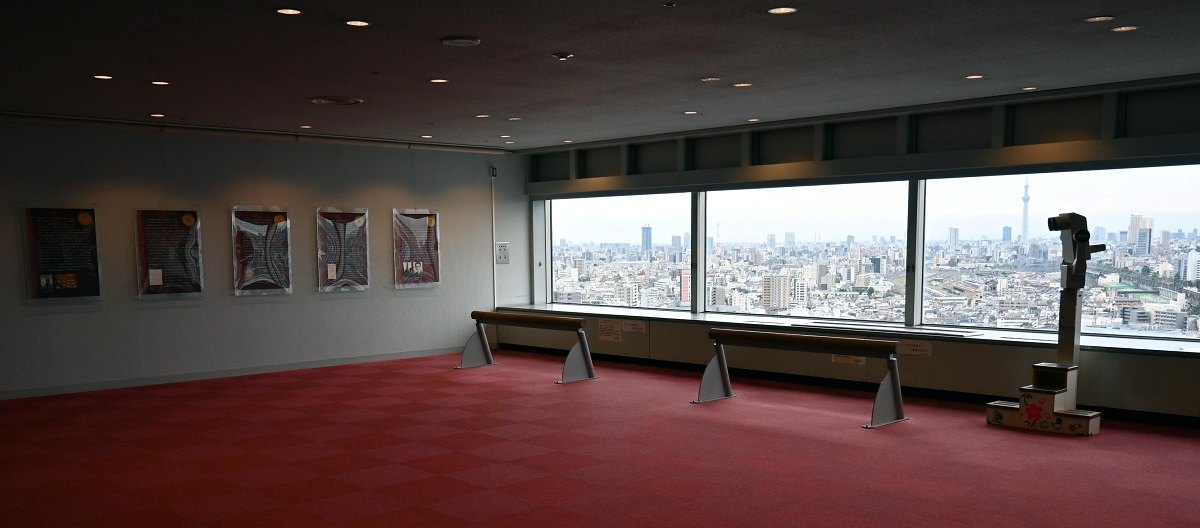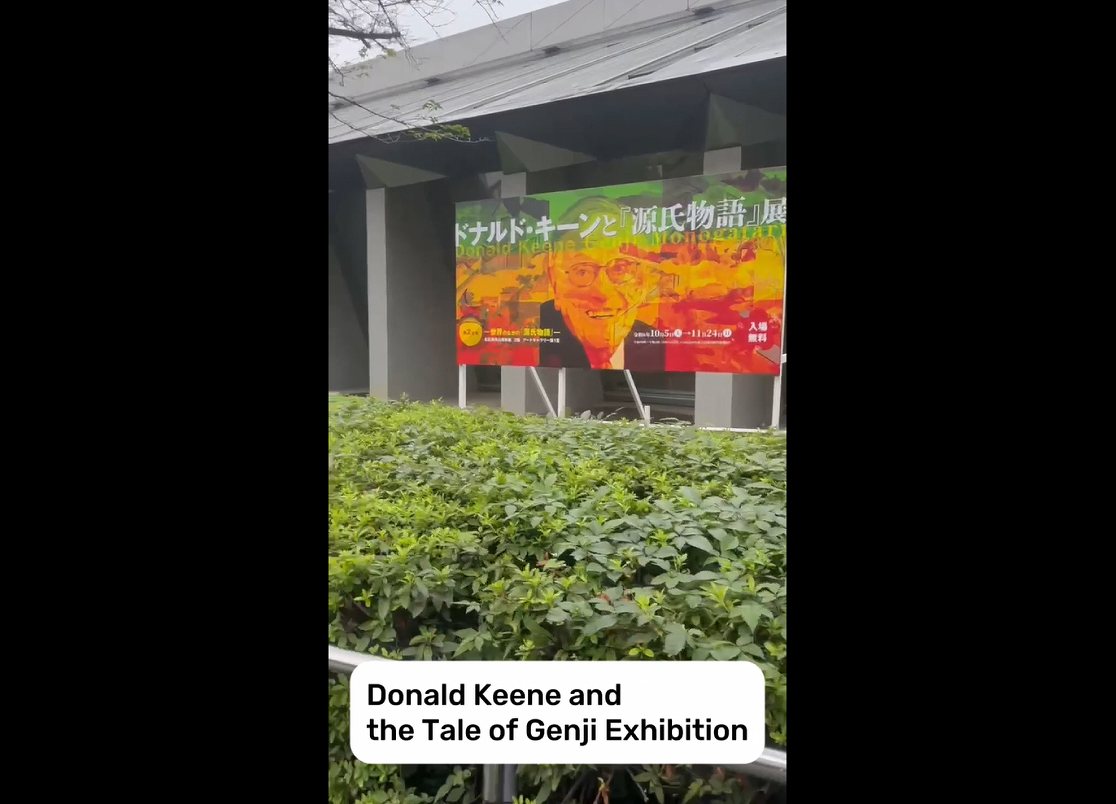Serendipitous “Genji” Encounter Changed Keene’s Life; Exhibition Shows Work’s Charms Through Scholar’s Eyes

Part of the “Donald Keene and ‘The Tale of Genji’” exhibition is being held on the 17th floor of the Hokutopia building in Kita Ward, Tokyo.
15:05 JST, October 16, 2024
An exhibition focusing on the connection between Donald Keene (1922-2019), who played a major role in introducing Japanese literature to the world, and the classic 11th-century novel “Tale of Genji” is being held in Kita Ward, Tokyo, where Keene lived for nearly half a century.
Keene was deeply impressed by the world of the “Tale of Genji” when he first encountered it at the age of 18, and it could be said that the experience shaped the course of his life. The exhibition “Donald Keene and ‘The Tale of Genji,’” organized by the Kita Ward government at two venues, uses display panels to trace Keene’s path. They include the full text of his October 1988 lecture about the “Tale of Genji,” which he gave in Takefu (now Echizen), Fukui Prefecture. The exhibition also includes translated editions of the “Tale of Genji” from around the world, and explores its significance as a work of world literature.
One day in 1940, Keene walked into a bookstore in New York’s Times Square. It wasn’t an ordinary bookstore, but one that offered books that weren’t selling well at a discount, and there were piles of Arthur Waley’s multivolume English translation of “The Tale of Genji.” Keene didn’t know that there was a story called “The Tale of Genji” or a writer called Murasaki Shikibu, but he was familiar with the name of Arthur Waley, a British oriental scholar. Keene bought two volumes for 49 cents and went home by subway.
“The year 1940 was a really bad year… The thing that troubled me the most was the war,” Keene said in his Takefu lecture. In Europe, Hitler’s Nazis had risen to power, and large area of France including Paris and Belgium had been occupied by Germany. Having received a heartfelt anti-war education from his father, Keene was convinced that “of all human actions, war is the ugliest,” and the dark atmosphere of war made him feel gloomy.
“I was amazed by the excellence of the English translation of ‘The Tale of Genji.’ It was truly magnificent,” Keene said in the lecture. “Of course, I didn’t know the original text at all, and I knew almost nothing about Japan, but the beauty of the English translation was indescribable.”
Keene became absorbed in reading the ancient tale because the world it depicted was completely different from the one he knew. There were no weapons and no wars. Instead, it was a world of romance, with the main character, Hikaru Genji, falling in love with various women. The wonderful thing about this story is that it teaches us that Genji fell in love through letters and music, and that he treated his love objects with affection forever. In his lecture, Keene reflected, “I immersed myself in the ‘Tale of Genji’ to forget the world that was before my eyes, and it gave me some solace.”
After encountering the work, Keene went on to become a language officer during World War II after studying at the Japanese language school of the U.S. Navy, and after the war he returned to Columbia University and studied under his mentor, Ryusaku Tsunoda. His path of research into Japanese literature led to research at Cambridge University in the United Kingdom and a stay in Japan while studying at Kyoto University from 1953.
Although Keene did not specialize in research into “The Tale of Genji,” he asserted in his lecture that “‘The Tale of Genji’ is undoubtedly the greatest masterpiece of Japanese literature.” All the characters are good people with no malicious intent, and they have wonderful cultural tastes. He regarded Murasaki Shikibu as being more sensitive to beauty than anyone else, and said she depicted the unique beauty of the Imperial court of the Heian period (794 to the late 12th century). He also suggested that she may have “escaped to the world of ‘The Tale of Genji’ because of her great worries about political matters.” Finally, Keene concluded by saying, “Murasaki Shikibu’s most outstanding characteristic was that she knew the human heart.”
‘Tale of Genji’ as world literature


Left: Foreign-language editions of “The Tale of Genji” are displayed at the Kita City Asukayama Museum.
Right: Arthur Waley’s translation of “The Tale of Genji,” held in the Donald Keene Memorial Foundation collection
In the second exhibition room, the literary value of “The Tale of Genji” and its global reach are introduced through an exhibition of “Westerners’ Appreciation of The Tale of Genji,” an article Keene wrote in Japanese in 1954 while he was studying at Kyoto University.
In addition to English translations by Arthur Waley and Edward Seidensticker, the “Tale of Genji” has been translated into French, Italian, Spanish and many other languages, and the exhibition displays books in these languages. According to one survey, the “Tale of Genji” has been translated into 43 languages. Here, we can see its universality as a work that transcends time and space.
Donald Keene and the Tale of Genji Exhibition

A panoramic view of Tokyo, including the Tokyo Skytree, can be enjoyed from the observation deck on the 17th floor of the Hokutopia building, the first venue of the exhibition.
The exhibition, with free admission, runs through Nov. 24 at two venues near Oji Station in Kita Ward, Tokyo. One venue is the 17th-floor observation gallery of the Hokutopia building, open daily from 8:30 a.m. to 10 p.m. The other venue is the third-floor art gallery of the Kita City Asukayama Museum, open from 10 a.m. to 5 p.m., but closed Mondays except November 4.
Japanese version
キーンさん「源氏」への愛、研究の原点出会い紹介…北区の2会場で展覧会
"JN Specialities" POPULAR ARTICLE
-

The Japan News / Weekly Edition (12/12-12/18)
-

Noodle Dining Shunsai / Rich Oyster Ramen to Savor at Odasaga; Experienced 68-year-old Owner Creates Numerous Ramen Varieties
-

The Japan News / Weekly Edition (12/5-12/11)
-

People Keep Loved Ones’ Ashes Close in Special Jewelry, Small Urns as Unique Way to Memorialize Them
-

The Japan News / Weekly Edition (12/19-12/25)
JN ACCESS RANKING
-

Tokyo Economic Security Forum to Hold Inaugural Meeting Amid Tense Global Environment
-

Keidanren Chairman Yoshinobu Tsutsui Visits Kashiwazaki-Kariwa Nuclear Power Plant; Inspects New Emergency Safety System
-

Imports of Rare Earths from China Facing Delays, May Be Caused by Deterioration of Japan-China Relations
-

University of Tokyo Professor Discusses Japanese Economic Security in Interview Ahead of Forum
-

Japan Pulls out of Vietnam Nuclear Project, Complicating Hanoi’s Power Plans


























